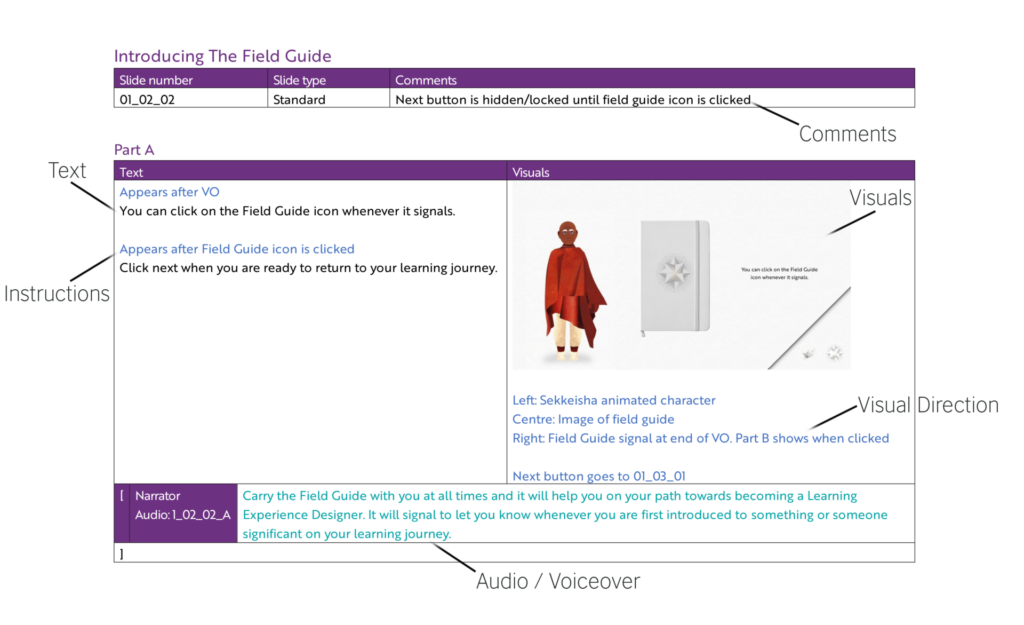Storyboarding: A Beginner's Guide
- Kayleigh Messinger and Hannah Webster

At Spokes Education we take pride in designing, developing and delivering innovative digital learning packages, and future blogs will outline the processes we take when creating our courses. We’ll be sharing each stage of our development process, and if you’re keen to learn all there is to know about great learning design, keep an eye on our LinkedIn page for updates on our upcoming course: UnfoldEd.
This blog will focus on how we storyboard content throughout the development process and outline the key features we include to make our storyboards as effective as possible.
Let’s begin by addressing the crucial question: What is storyboarding?
A storyboard is a document we create based on the content we receive from our clients. It forms the scaffold for how we’ll structure each course, and clients can review and make amendments at an early stage – which is far easier than having to adjust a course that has already been developed! Our company founder Phil highlights the benefits storyboarding has within a team:
“Detailed storyboards provide very clear direction on how the course will be constructed, which expedites the process in a number of ways. Firstly, it gives the client a comprehensive view on how the course will look and function so that a number of questions and issues are addressed up front. Secondly, it makes the developer’s job a lot quicker and easier. Thirdly, the storyboard becomes the central document and “source of truth”, so it helps with version control. Finally, our storyboards are set up to run a macro to quickly extract all audio into a script, with references, ready to send to a voiceover artist.”
So where do you start?
Whether you’re familiar with storyboarding, or not, it can be hard to know exactly what to include. We have compiled the most important elements and how we use them to improve our development process and subsequently enhance client satisfaction and learner experience.

Slides
Your course should be split into slides, and depending on the course you’re designing, these may feature additional elements, such as click and reveal sections, or additional layered content. If we utilise layers, these slides will have a Part B, C etc, so we can demonstrate how the content is broken down.
Text
You should detail exactly what textual information you will include on the slide, so you can review and amend what will be written before the project is developed further.
Visuals
Any visuals such a graphics or images should be included with their corresponding slide. This may include current assets or descriptions of future assets to be developed. Noting this down in the storyboard will ensure everyone on the team will know what needs to go where, allowing everyone to locate each visual with ease.
Audio
Audio is a great way to make courses more accessible and support the on-screen content, so outline exactly what you want the audio to say. This can also be used to develop closed captioning if you choose to include it. (For more ways to make your courses more accessible, see our previous blog). You’ll notice that there is an extra line underneath the audio row, with a single closed bracket. This is there for the purposes of a macro we run to rapidly extract the audio script. The macro code can be downloaded here if you want to use it.
N.B. Documents with macros will usually get rejected by email servers, so make sure it’s removed if you need to send it to a client!
Instructions
Instructions can be used to outline exactly what will be happening on the slide and when. You should include as much detail as possible, for example when text or visuals should appear or any animations that will be included. We find that the instructions act as a general guide, however in development the team may need to adjust these to be more functional to the restrictions of the software, e.g. Storyline, or to enhance the content once all the elements are viewed together to ensure the best learning experience possible.
Comments and Questions
Your storyboard will be shared with your clients, so the ability to leave comments and questions is vital! It’s the best way to ensure they’re happy with everything you plan to do and make any changes early on – helping you to perfectly meet your clients’ needs. We tend to find it is easier to work on shared documents either in one drive or google docs. This allows us to work alongside our clients on updates, ensuring version control and reduced waiting times for review responses.
Hopefully you now have the ability to transform your development process. Combine each of these elements and you’ll have a great storyboard. Keep an eye on our upcoming blogs as we take you through the various stages of course development, and make sure you’re connected to our social media pages, so you never miss an update!


















